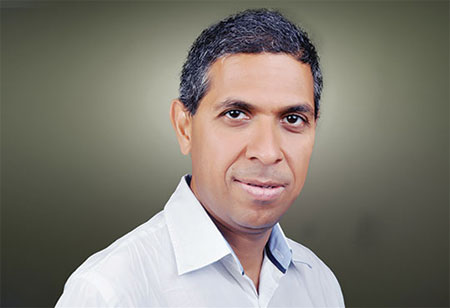Digital is Now Abundant and Attention is Scarce
By Rajeev Banduni, Co founder and CEO, GrowthEnabler

Rajeev Banduni, Co founder and CEO, GrowthEnabler
If the information in every letter delivered by the US Postal Service in 2010 was added up, the amount would be equal to roughly five petabytes (1 petabyte is equivalent to nearly 10,000 hours of TV!). Google processes the same magnitude of data on a slow afternoon. That is a whole lot of information. 90 percent of all the data in the world today has been created in the last 2 years (IBM). Welcome to the digital information era.
The situation is just as extreme if you look at our personal interactions. A study by Martin Hilbert, showed the amount of two-way communication people have daily (including phone, email, and text conversation) has risen from the equivalent of two newspaper pages in 1986 to 20 entire newspapers in 2010. It is as if our kitchen faucet was replaced by a high pressure fire hose, spraying us in the face with a deluge of data. The point of the fire hose metaphor is that no matter how wide you open your mouth, you can drink only so much and may be even less because of the force of the water. Similarly, the human mind has constraints on how much information it can process irrespective of what is on the screen. The amount of information on the monitor will always be exponentially greater than our individual capacity to absorb and focus on multiple things at the same time.
As a Nobel prize-winning psychologist, Herbert Simon, once said, “A wealth of information creates a poverty of attention.” We’re in a new digital world where money is made via an Attention Economy and Facebook is a great example of an Attention Economy. Facebook cleverly inserts relevant business posts/ads into our news feed, capturing our attention on behalf of their paying customers.
Lesson: It’s becoming clear that human attention has become the sweet crude oil of the 21st century. With the magnitude of information coming towards us, and our limited ability to process it there lays an opportunity. Businesses that provide filtered, relevant and bitesize information will have greater leverage of customer attention. If the user experience is easy enough, they may even be able to charge a premium.
George Miller’s paper, presented at MIT in 1956, (“The Magical Number Seven, Plus or Minus Two”) found that the brain cannot remember more than 7 numbers. Nelson Cowan, a psychology professor at University of Missouri, found in his research in 2001 that Miller’s magical number was way too optimistic. Cowan argued that the true magical number is actually 4 (+/-1), with most tests of working memory showing that we start to miss crucial information whenever the number of bits (letters, words, numbers, colours whatever) exceeds that amount. Glenn Wilson, a psychologist at Gresham College, London, found that simply having an unread email in your inbox is distracting enough to reduce your effective IQ score by roughly ten points.
If everything is important then nothing
In light of this, how can you model your interaction with prospective buyers or customers? There are various channels to interact with your prospects: Website, Social Media (Facebook, Twitter, LinkedIn etc), Messengers (WhatsApp, Snapchat, Facebook messenger etc), and Mobile apps, among others.
Trying to grab attention, when the human mind’s limitation disallows them to remember more than 4 numbers, is hard. Let’s focus on your primary way of connecting with your prospective clients: Website. When Obama care was rolled out via US Govt health care website (www.healthcare.gov) for the first time, it was found that people were confused and could not decide which insurance option to choose. Some people had to pick from more than 150 options and it was hard for them to decide which option is best and most of them probably ended up making poor insurance choices (Study by Saurabh Bhargava, George Loewenstein, and Shlomo Benartzi). Most of them chose plans that were $888 more than what was required. In today’s digital environment, we have more choices but we choose wrongly. We have more information but we somehow miss the most important details. We can act quickly with information in our hand but that often means we act without thinking. One of the fundamental insights of OTA (Online Travel agents) such as Expedia or Booking.com is that they carefully control the quality of hotel information on display. Consumers are so overwhelmed with alternatives that they have to be guided through the decision making process, providing them with easy categories and big buy buttons. Instead of displaying all the information, buyers are carefully shown the most important variables, location and prices. Too many hotel websites are yet to learn this lesson. The lesson here is simple; we need to treat attention as a literal resource.
The Digital world has become so pervasive that it allows us to reach millions of people with little effort. In fact, influencing behaviour online can be efficient and effective but this opportunity comes with a caveat. Now the big question: Is your website ready to take advantage of the digital world?
Here are some of best practices for an engaging website:
1. Have you thought about the limitation of attention while designing the layout of a webpage? Remember the magical number is ‘4’.
2. Have you factored in and catered for an attention environment? Remember: People are multitasking.
3. Have you looked at ways to compress information? Example: Substituting sentences with pictures.
4. Have you considered ways to boost attention? Example: Video is more engaging than standard text format.
In a world where people are overwhelmed with their emails and Facebook updates, the key is to keep it simple and minimal.
Current Issue
🍪 Do you like Cookies?
We use cookies to ensure you get the best experience on our website. Read more...









